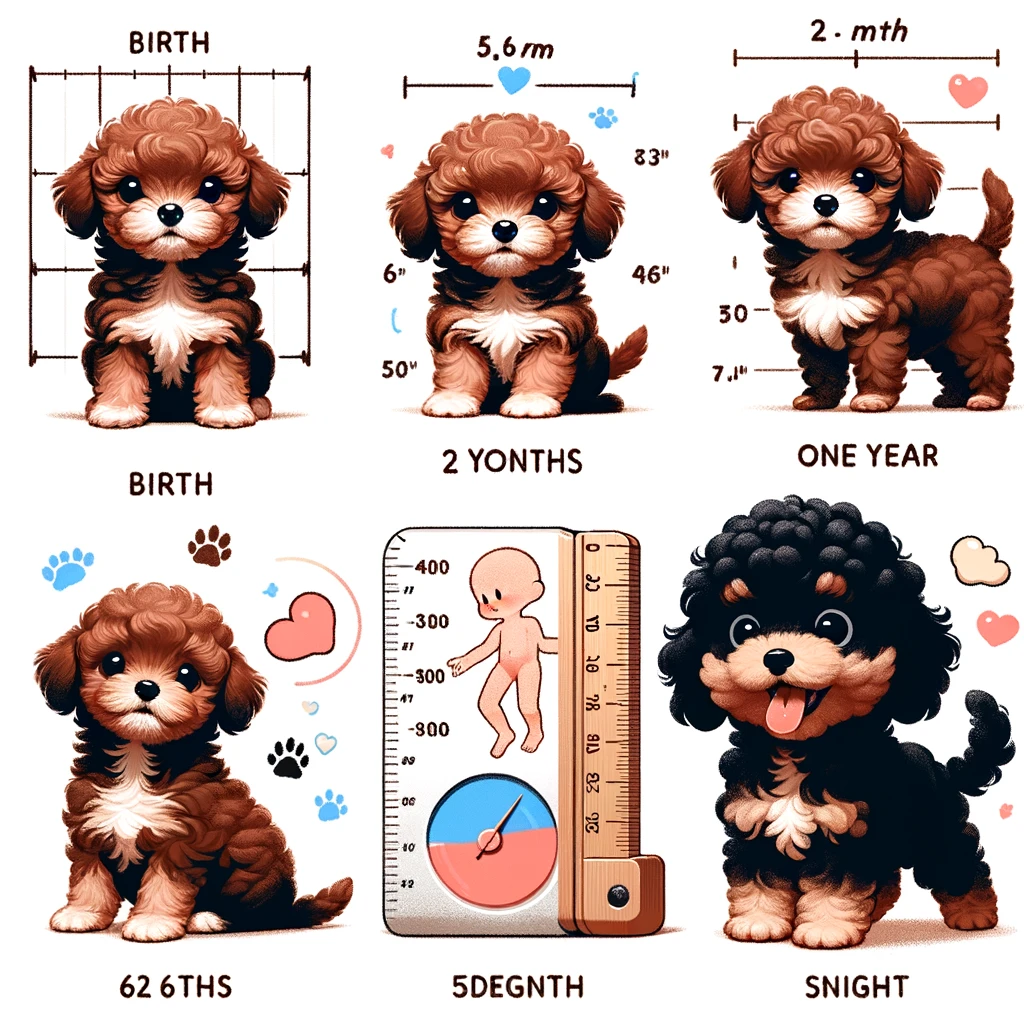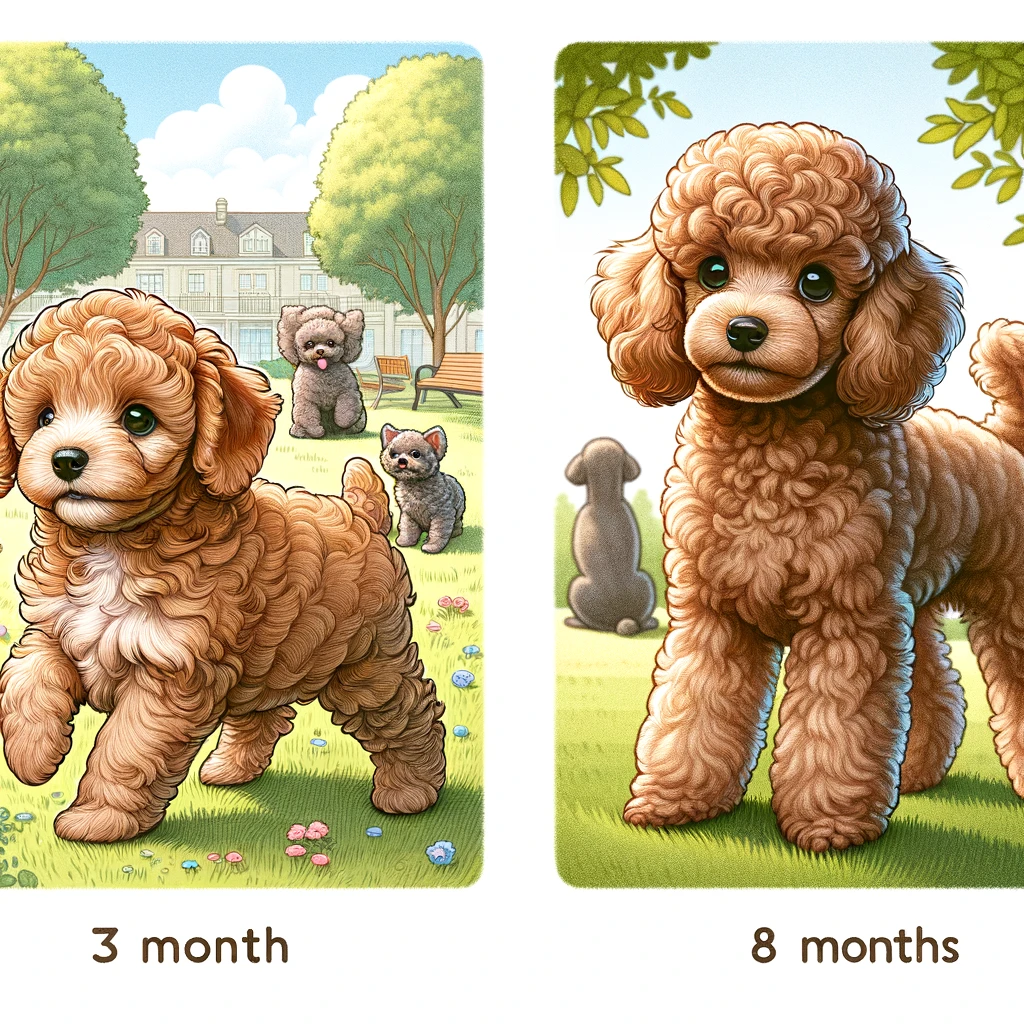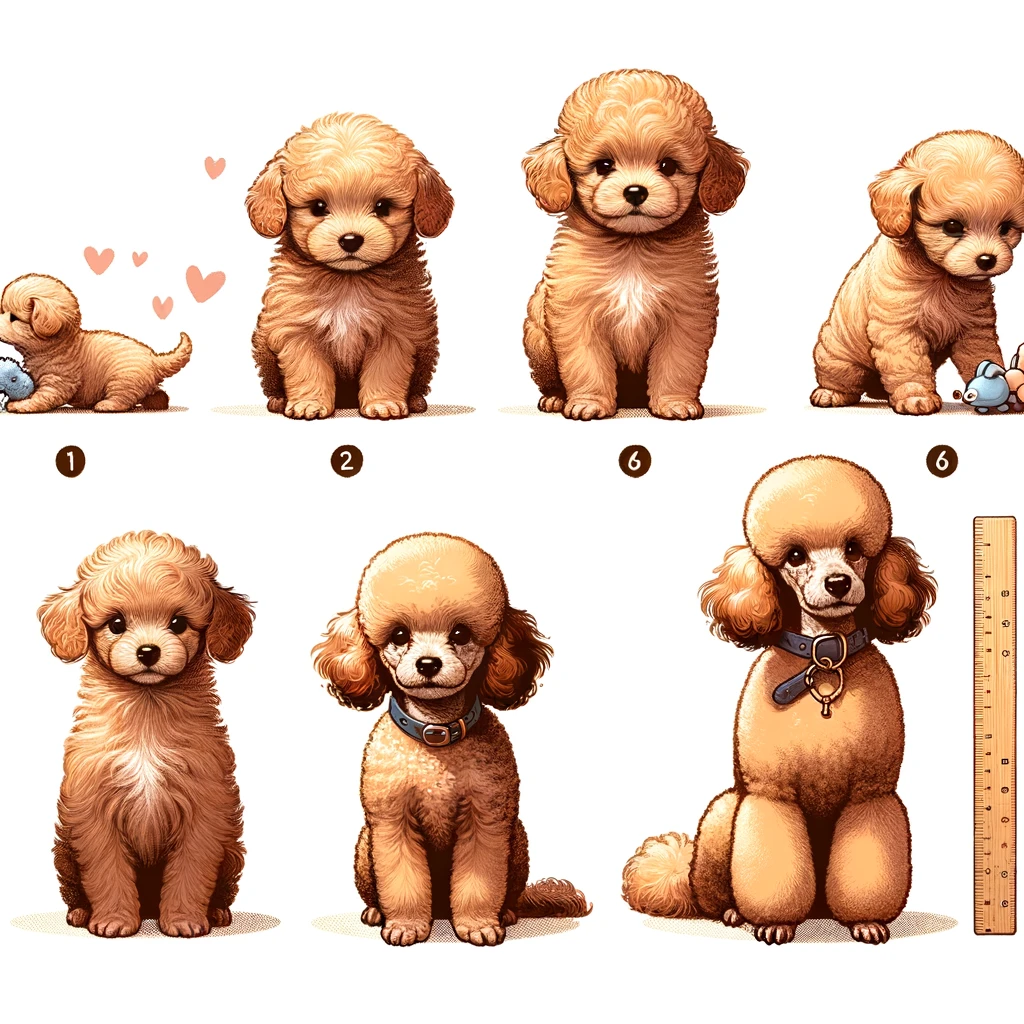Introduction to mini poodle growth chart & adult weight calculator
Mini Poodle has captured the hearts of many dog lovers with its sharp wit and graceful attitude. Hailing from France, these canines are non-allergenic and have a tiny stature that qualifies them as Miniature. Their label as “Mini Poodles” highlights their exceptional size division, setting them apart from their larger Standard and smaller Toy variations. We will discuss here the mini poodle growth chart and calculator to predict the weight of your miniature poodle.
Although small in size, this particular breed boasts a spirited and loving personality, making them perfect companions for any type of lifestyle. It’s important for owners to understand the growth cycle of Mini Poodles, as it helps to ensure they receive the proper nutrition and care. This Mini poodle’s growth chart is an invaluable tool for monitoring the healthy progression of a Mini Poodle from infancy to maturity. Puppies will slowly begin to learn how to walk, but for the most part, they will be sleeping and eating. During this stage, close supervision must be given to any Miniature Poodle puppies. Owners should allow the poodle to adapt to their surroundings while still being prepared to intervene and give help if needed.
Understanding Mini Poodle Size
The charming miniature poodle’s, affectionately known as the Mini Poodle, falls in between its two Poodle relatives – the larger Standard Poodle, the miniature and Poodle. This compact canine typically measures 10 to 15 inches at the shoulder, making them the perfect blend of size and agility. In contrast, the Standard Poodle can tower over 15 inches, with some even reaching a height of 22 inches tall or more, while the miniature Toy Poodle stands at 10 inches or less.
Mini Poodles possess an abundance of personality and cleverness within their tiny bodies. Their well-balanced physical features and refined attitude maintain the signature grace of the Poodle breed. These tiny canines make excellent companions and are adaptable to all types of living situations, whether it’s a cozy apartment or a spacious house with a backyard.
Compared to their Toy Poodle counterparts, Mini Poodles are strong and can partake in more vigorous activities and play, making them a fantastic option for individuals or families with an active lifestyle.
Mini Poodle Growth Chart Overview
The growth line of Mini Poodles is characterized by a reliable pattern, typically reaching completion between 12 to 15 months. Throughout this phase, they experience rapid growth in both size and weight in pounds. While most Mini small dog reach their full height by 6 to 7 months, it is not uncommon for them to continue developing and gaining muscle well into their first year.
A Mini Poodle’s growth chart ultimate dimensions can be shaped by factors like genetics, nutrition, and overall well-being. Typically, a mature Mini Poodle tips the scale at 12 to 20 pounds as an average weightand measures 10 to 15 inches in height at the shoulder. This moderate size allows for easy handling and care, making them a convenient choice for most pet owners.
It is crucial for owners to closely track their Mini Poodle’s growth to prevent potential health issues caused by excessive weight gain. A well-rounded diet and regular physical activity are essential for maintaining a healthy growth rate. By familiarizing themselves with the growth chart, owners can anticipate the changing dietary and exercise needs of their Mini Poodle as they progress from puppyhood to adulthood.

Detailed Miniature Poodle Growth Chart and Weight Calculator
As the Mini Poodle grows, we can track their progress using age-specific milestones that mainly measure their height and weight. Here’s a detailed breakdown of mini poodle weight calculator and mini poodle or puppy growth chart and calculator:
During the first two months: They are born as tiny bundles of joy, typically weighing just 2 to 4 pounds. As they grow and develop, they can reach a weight of 4 to 6 pounds by the time they reach 2 months old.
During the span of 3 to 4 months: A pup experience a burst of growth. They may reach a weight of 6 to 9 pounds and their height will noticeably increase. We can thus easily estimate the adult size and weight.
At around 5 to 6 months old: Puppies begin to experience a slight decrease in their height growth rate, reaching about half their adult weight or 80% of their adult height. However, their weight continues to steadily climb, usually reaching between 10 to 15 pounds.
Between 7 to 9 months: Mini Poodles experience a substantial decrease in growth rate. They typically reach their adult height, measuring between 10 to 15 inches, and weigh an average of 12 to 18 pounds.
Around 10 to 12 months of age: A significant change occurs for growing individuals as they stop increasing in height and instead reach their final weight as adult poodle. This weight usually falls within the range of 12 to 20 pounds.
Between 12 to 15 months of age: These animals begin to fill out and develop a strong and mature adult coat. Their muscles also become more defined during this stage.
| Age (Months) | Height (Inches) | Weight (Pounds) |
| Birth | N/A | 2 – 4 |
| 2 | N/A | 4 – 6 |
| 3 – 4 | Growing | 6 – 9 |
| 5 – 6 | Near Adult Height | 10 – 15 |
| 7 – 9 | Adult Height (10 – 15) | 12 – 18 |
| 10 – 12 | Adult Height (10 – 15) | 12 – 20 |
| 12 – 15 | Adult Height (10 – 15) | Adult Weight |
Factors Influencing Mini Poodle Growth
Several factors influence the growth patterns of Mini Poodles:
Genetics: The size of a Mini Poodle is greatly influenced by genetics. Looking at the size of the parents, one can often predict how big a puppy will grow. In other words, genetics hold a significant influence on the ultimate size of a Mini Poodle.
Spaying/Neutering: These measures can have a minor impact on growth. Puppies spayed or neutered at a young age may experience slightly increased growth due to the growth plates taking longer to close
Health: A healthy diet and proper care ensure optimal growth. Illnesses or nutritional deficiencies during puppyhood can impact their growth and overall size.
Read: What is a King Poodle? A Guide to This Royal Dog Breed
Cross-Breeds and Their Growth
Cross-breeding Mini Poodles with other breeds results in puppies whose size can vary significantly, depending on the other breed involved. For example:
“Cockapoos are a delightful mix of Cocker Spaniel and Mini Poodle, typically varying in size from small to medium. In fact, they are known to weigh more than a purebred Mini Poodle. “
The Maltipoo, a delightful mix of Maltese and Mini Poodle, is known for its petite size, often comparable to that of Mini Poodles, yet on occasion, even tinier.
“Meet the Mini Labradoodle – a delightful blend of Mini Poodle and Labrador genetics. Don’t let the name fool you, these pups are typically bigger than their Mini Poodle counterparts, thanks to their Labrador lineage.”
The growth rate and final size of crossbreeds can be less predictable and depend heavily on the characteristics of both parent breeds.
Choosing the Right Poodle Size
Selecting the right Poodle size is an important decision and depends on several factors:
Living Space: For larger Poodles, it’s important to have enough space to roam and stretch their legs. On the other hand, Mini or Toy Poodles are better suited for compact living spaces like apartments or small homes.
Lifestyle and Activity Level: Active families would find Standard Poodles to be a perfect fit due to their high energy and need for regular exercise. On the other hand, Mini and Toy Poodles can easily adjust to a more sedentary lifestyle.
Allergies and Grooming: Poodles are widely recognized for their hypoallergenic coats, though their grooming requirements increase according to their size. In fact, Standard Poodles generally demand a greater level of grooming than their smaller counterparts, such as Mini or Toy Poodles.
Family Structure: For families with young kids, a sturdy and patient Standard Poodle may be the perfect choice. However, older couples or individuals may opt for a Mini or Toy Poodle as they are easier to handle. It’s worth noting that larger breeds, like Standard Poodles, may have a unique set of potential health problems compared to smaller Poodles.
Growth Milestones and Development Stages
Poodles go through several developmental stages from birth to adulthood:
Neonatal (0-2 weeks): puppies are completely dependent on their mother as they are born without the ability to see or hear. Their main activities include sleeping and feeding.
Socialization (3-12 weeks): During this pivotal period, puppies are introduced to a variety of stimuli, such as humans, other animals, and diverse surroundings. This is when they develop crucial social skills, engage in playful behaviors, and discover their surroundings.
Adolescence (3-6 months): During their development, puppies undergo a phase of speedy growth and hormonal fluctuations. This period is characterized by a newfound sense of freedom, inquisitiveness, and occasional displays of challenging behavior.
Sexual Development (6-12 months): “At the stage when our furry four-legged friends enter the throes of adolescence and reach sexual maturity. A time when diligent owners keenly observe shifts in behavior and physical growth. It also marks a pivotal moment in deciding on spaying or neutering for our beloved fur babies.”
Adulthood (1 year and beyond): Once poodles reach the one-year mark, they are considered fully grown and their individual characteristics have solidified. However, it is crucial to continue providing them with training, socialization, and proper care to support their overall well-being and development.
Understanding these stages helps in providing appropriate care and training at each phase of a Poodle’s life.

Health and Lifespan
Although Mini Poodles typically have a lifespan of 12 to 15 years and are generally a robust breed, they, like any other breed, may experience certain health concerns. These include hip dysplasia, which affects the hip joint, progressive retinal atrophy, a condition that can cause blindness, and luxating patellas (slipping kneecaps) and ear infections, common issues due to their floppy ears.
However, by regularly taking them to the veterinarian, providing a balanced diet, and ensuring they receive regular exercise, these risks can be minimized. It’s crucial for potential owners to be aware of these potential health concerns and to obtain Mini Poodles from reputable breeders who conduct health screenings on their breeding dogs.
| Health Issue | Description | Prevention/Treatment |
| Hip Dysplasia | Joint problem affecting the hip | Regular vet check-ups, proper diet and exercise |
| Progressive Retinal Atrophy | Eye disorder leading to blindness | Regular eye exams, genetic testing |
| Luxating Patellas | Slipping kneecaps | Weight management, surgery in severe cases |
| Ear Infections | Common due to floppy ears | Regular ear cleaning and check-ups |
Cost of Owning a Mini Poodle
Getting a Mini Poodle can come with a hefty price tag, ranging from $1,000 to $2,500 depending on factors such as the breeder’s reputation and the doggo’s lineage. And don’t forget about the ongoing upkeep! From top-notch food to grooming to routine vet check-ups and vaccinations, there are definitely some recurring expenses to consider. Plus, those cute curly locks require frequent professional grooming, which can add up over time.
Furthermore, it’s important for owners to account for additional expenses when budgeting for a Mini Poodle. These may include fees for spaying or neutering, microchipping, and preventative medications to protect against parasites. It’s also important to consider the costs for training, toys, and bedding to keep your furry friend happy and healthy. On average, the maintenance expenses for a Mini Poodle can range from $500 to $1,000 per year. It’s worth noting that this does not include unexpected health emergencies or the option for pet insurance.
| Cost Type | Estimated Cost |
| Purchase | $1,000 – $2,500 |
| Food | Varies with diet choice |
| Grooming | Regular professional grooming required |
| Veterinary Care | Annual check-ups, vaccinations, emergencies |
| Additional Costs | Training, toys, bedding, etc. |
Managing Weight and Exercise
It is vital for Mini Poodles to maintain a healthy weight and stick to a consistent exercise routine. These canines are full of energy and need daily physical activity to thrive and avoid becoming overweight. A mix of walks, play sessions, and mentally stimulating tasks is highly encouraged. Regular exercise not only helps keep their weight in check, but it also helps prevent behavioral problems that may stem from boredom or excess energy.
Having a well-balanced diet is crucial for the health of a Mini Poodle. It’s vital to feed them high-quality dog food that fits their age, size, and activity level. To avoid overfeeding, keeping track of portions and limiting treats is essential. It’s also important to schedule regular check-ups with a veterinarian to monitor their weight and make necessary adjustments to their diet. By providing a balanced lifestyle that includes proper exercise and nutrition, we can ensure the overall well-being of our furry friends. Big your poodle is always a bundle of love and joy.
Read: Corded Poodles: A Guide to Their Unique Coat Style
FAQs
Q: How long is a Mini Poodle’s pregnancy?
Like many other dog breeds, pregnancy in Mini Poodles typically lasts for approximately 63 days.
Q: What is the average litter size for Mini Poodles?
The average litter size for Mini Poodles is around 4 to 6 puppies.
Q: At what age can Mini Poodles start breeding?
Once they have reached physical maturity, typically at 18 months for females and 12 months for males, they should be bred.
Q: How often can a Mini Poodle have puppies?
To maintain the health and well-being of the female dog, it’s advised to limit breeding to a maximum of once every 12-18 months.
Q: How can I tell if my Mini Poodle is pregnant?
There are several tell-tale signs of pregnancy in animals, such as changes in behavior, a noticeable increase in appetite and weight, and even growth of the nipples. To confirm pregnancy, it’s best to consult a veterinarian who can conduct an ultrasound or a blood test for accurate results.
Q. What is difference between miniature and standard poodle?
Here is the difference between miniature and standard poodle:
- Size: Standard Poodles are over 15 inches tall at the shoulder, making them the largest of the breed, while Miniature Poodles stand between 10 to 15 inches.
- Weight: Standard Poodles weigh between 40-70 pounds, significantly more than Miniature Poodles, which typically weigh 10-15 pounds.
Q: What are the considerations for breeding Mini Poodles?
Before embarking on the breeding process, it is crucial to carefully consider factors such as genetic health testing, the dog’s overall well-being, temperament, and the responsibilities that come with caring for a pregnant dog and her puppies. Seeking advice from both a trusted veterinarian and a seasoned breeder is highly recommended.
| Question | Answer |
|---|---|
| How long is a Mini Poodle’s pregnancy? | About 63 days |
| What is the average litter size? | 4 – 6 puppies |
| At what age can Mini Poodles start breeding? | Females: 18 months, Males: 12 months |
| How often can a Mini Poodle have puppies? | Once every 12-18 months |
| How to tell if a Mini Poodle is pregnant? | Behavioral changes, increased appetite, weight gain, nipple growth |
| Considerations for breeding? | Genetic health, overall health, temperament, care for puppies |

